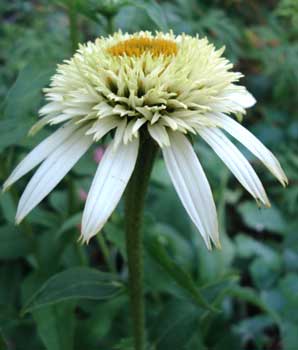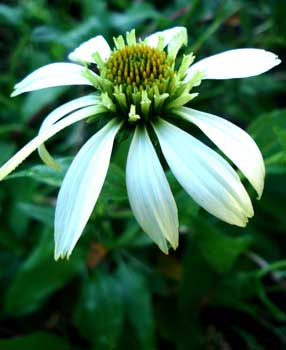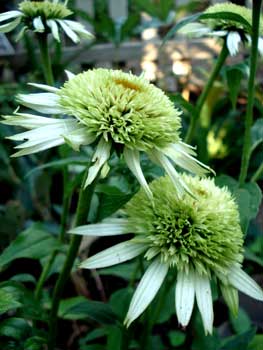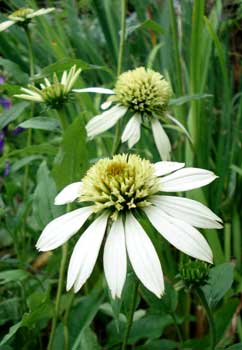
'Coconut Lime'
Double Coneflower
"O! mickle is the powerful grace that lies
In herbs, plants, stones, & their true qualities:
For nought so vile that on the earth doth live
But to the earth some special good doth give."
-Romeo & Juliette
William Shakespeare
(1564-1616)
William Shakespeare
(1564-1616)
 A vigrorous reliable cultivar & very stable, the white double coneflower Echinacea purpurea 'Coconut Lime,' in production since 2005, is exceedingly beautiful.
A vigrorous reliable cultivar & very stable, the white double coneflower Echinacea purpurea 'Coconut Lime,' in production since 2005, is exceedingly beautiful.As the "shake out" continues for which of the scores of new Echinacea varieties will survive the long term, versus those which will fall by the wayside, I've a strong suspicion 'Coconut Lime' will be one of the survivors.
It is the second of the "ConeFections" series. (Cone Fections, get it, ha ha). It was preceded by 'Pink Double Delight' which claimed to be a performance-improvement over the very first double-coneflower ever, 'Razzmatazz.'
 'Coconut Lime' was the world's first white double, bred by Arie Blom of Vleuten, the Netherlands. It was soon followed by the third Confections cultivar, 'Meringue,' a dwarf white usually only reaching about eighteen inches tall.
'Coconut Lime' was the world's first white double, bred by Arie Blom of Vleuten, the Netherlands. It was soon followed by the third Confections cultivar, 'Meringue,' a dwarf white usually only reaching about eighteen inches tall.The mature bloom of 'Coconut Lime' is a cream pompom-cone with fully reflexed pure white petals forming a skirt around the bottom edge of the cone.
The topmost center of the cone is frequently pale orange to amber brown, qualifying it as truly bicolor, or tricolor if one counts the jade green component, though this cap is not invariably visible. It's the actual cone, of course, diminutive compared to standard coneflowers, & the rest of the pompom is tiny petals.
 The young bloom is quite different in that it's almost a normal daisy, & is great fun to watch transform over a period of a couple weeks. The large horizontal petals seem actually to shrink as they slowly draw backward into a fringed skirt & the pompom swells to dominance.
The young bloom is quite different in that it's almost a normal daisy, & is great fun to watch transform over a period of a couple weeks. The large horizontal petals seem actually to shrink as they slowly draw backward into a fringed skirt & the pompom swells to dominance.Each bloom lasts a very long time, & it blooms continuously, new blooms developing one after another after another. It will be in flower from July to September or even longer, until the first hard frost arrives.
You can speed up the reflowering by deadheading or taking for bouquets at least the first round of mature blooms. A mature clump will produce dozens of flowers each year. Longlasting as cut flowers, however, fact is, they're much more longlasting left on the clump.
Usually less than two feet tall, the stems are fairly sturdy, but they can tip a bit, usually not so much as to need staking. They have a faint vanilla-straw perfume that you have to get right down close to detect, but more noticeable indoors in the bouquet.
It's not as drought-hardy as the old standard coneflowers so put it in a moderately watered but sharply draining soil. It might seem a little delicate its first year or full sun may brown the fringe-skirt if the soil is at all dry. But once it has a good root system this won't happen; it'll delight in full sun. Advertised as suitable to USDA zones 4 through 10, count on it more reasonably for zones 6 through 8.
Continue to:
'Rocky Top' Tennessee Coneflower